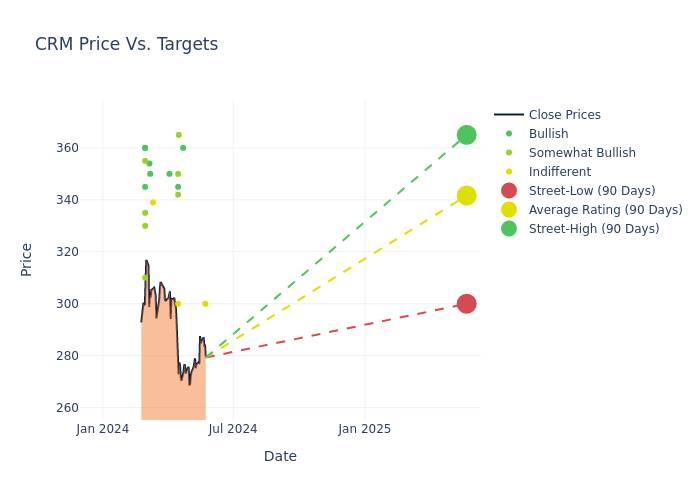Evaluating Salesforce: Insights From 26 Financial Analysts

26 analysts have expressed a variety of opinions on Salesforce (NYSE:CRM) over the past quarter, offering a diverse set of opinions from bullish to bearish.
The following table summarizes their recent ratings, shedding light on the changing sentiments within the past 30 days and comparing them to the preceding months.
| Bullish | Somewhat Bullish | Indifferent | Somewhat Bearish | Bearish | |
|---|---|---|---|---|---|
| Total Ratings | 10 | 10 | 6 | 0 | 0 |
| Last 30D | 0 | 0 | 1 | 0 | 0 |
| 1M Ago | 0 | 0 | 0 | 0 | 0 |
| 2M Ago | 3 | 4 | 1 | 0 | 0 |
| 3M Ago | 7 | 6 | 4 | 0 | 0 |
Analysts have recently evaluated Salesforce and provided 12-month price targets. The average target is $337.38, accompanied by a high estimate of $365.00 and a low estimate of $285.00. Surpassing the previous average price target of $303.90, the current average has increased by 11.02%.

Investigating Analyst Ratings: An Elaborate Study
A comprehensive examination of how financial experts perceive Salesforce is derived from recent analyst actions. The following is a detailed summary of key analysts, their recent evaluations, and adjustments to ratings and price targets.
| Analyst | Analyst Firm | Action Taken | Rating | Current Price Target | Prior Price Target |
|---|---|---|---|---|---|
| Michael Turrin | Wells Fargo | Lowers | Equal-Weight | $300.00 | $310.00 |
| Brent Thill | Jefferies | Raises | Buy | $360.00 | $350.00 |
| Alex Zukin | Wolfe Research | Maintains | Outperform | $365.00 | – |
| Patrick Walravens | JMP Securities | Maintains | Market Outperform | $342.00 | – |
| Rishi Jaluria | RBC Capital | Maintains | Outperform | $350.00 | – |
| Scott Berg | Needham | Maintains | Buy | $345.00 | – |
| Brent Bracelin | Piper Sandler | Maintains | Neutral | $300.00 | $300.00 |
| Rishi Jaluria | RBC Capital | Raises | Outperform | $350.00 | $325.00 |
| Parker Lane | Stifel | Maintains | Buy | $350.00 | – |
| Tyler Radke | Citigroup | Raises | Neutral | $339.00 | $325.00 |
| David Hynes | Canaccord Genuity | Maintains | Buy | $350.00 | $350.00 |
| Joseph Bonner | Argus Research | Raises | Buy | $354.00 | $290.00 |
| Patrick Walravens | JMP Securities | Raises | Market Outperform | $342.00 | $293.00 |
| Kirk Materne | Evercore ISI Group | Raises | Outperform | $330.00 | $290.00 |
| Rishi Jaluria | RBC Capital | Raises | Outperform | $325.00 | $285.00 |
| Mark Murphy | JP Morgan | Raises | Overweight | $310.00 | $260.00 |
| Brad Sills | B of A Securities | Raises | Buy | $360.00 | $350.00 |
| Gregg Moskowitz | Mizuho | Raises | Buy | $345.00 | $325.00 |
| David Hynes | Canaccord Genuity | Raises | Buy | $350.00 | $290.00 |
| Terry Tillman | Truist Securities | Raises | Buy | $360.00 | $275.00 |
| Keith Bachman | BMO Capital | Raises | Outperform | $335.00 | $325.00 |
| Scott Berg | Needham | Raises | Buy | $345.00 | $275.00 |
| Rob Oliver | Baird | Raises | Outperform | $355.00 | $310.00 |
| Brent Bracelin | Piper Sandler | Raises | Neutral | $300.00 | $285.00 |
| Brent Bracelin | Piper Sandler | Maintains | Neutral | $285.00 | – |
| Tyler Radke | Citigroup | Raises | Neutral | $325.00 | $265.00 |
Key Insights:
- Action Taken: Analysts adapt their recommendations to changing market conditions and company performance. Whether they ‘Maintain’, ‘Raise’ or ‘Lower’ their stance, it reflects their response to recent developments related to Salesforce. This information provides a snapshot of how analysts perceive the current state of the company.
- Rating: Unveiling insights, analysts deliver qualitative insights into stock performance, from ‘Outperform’ to ‘Underperform’. These ratings convey expectations for the relative performance of Salesforce compared to the broader market.
- Price Targets: Gaining insights, analysts provide estimates for the future value of Salesforce’s stock. This comparison reveals trends in analysts’ expectations over time.
For valuable insights into Salesforce’s market performance, consider these analyst evaluations alongside crucial financial indicators. Stay well-informed and make prudent decisions using our Ratings Table.
Stay up to date on Salesforce analyst ratings.
Unveiling the Story Behind Salesforce
Salesforce Inc provides enterprise cloud computing solutions. The company offers customer relationship management technology that brings companies and customers together. Its Customer 360 platform helps the group to deliver a single source of truth, connecting customer data across systems, apps, and devices to help companies sell, service, market, and conduct commerce. It also offers Service Cloud for customer support, Marketing Cloud for digital marketing campaigns, Commerce Cloud as an e-commerce engine, the Salesforce Platform, which allows enterprises to build applications, and other solutions, such as MuleSoft for data integration.
Financial Milestones: Salesforce’s Journey
Market Capitalization Analysis: With an elevated market capitalization, the company stands out above industry averages, showcasing substantial size and market acknowledgment.
Revenue Growth: Salesforce’s remarkable performance in 3 months is evident. As of 31 January, 2024, the company achieved an impressive revenue growth rate of 10.77%. This signifies a substantial increase in the company’s top-line earnings. As compared to its peers, the revenue growth lags behind its industry peers. The company achieved a growth rate lower than the average among peers in Information Technology sector.
Net Margin: Salesforce’s net margin excels beyond industry benchmarks, reaching 15.57%. This signifies efficient cost management and strong financial health.
Return on Equity (ROE): The company’s ROE is below industry benchmarks, signaling potential difficulties in efficiently using equity capital. With an ROE of 2.46%, the company may need to address challenges in generating satisfactory returns for shareholders.
Return on Assets (ROA): The company’s ROA is below industry benchmarks, signaling potential difficulties in efficiently utilizing assets. With an ROA of 1.52%, the company may need to address challenges in generating satisfactory returns from its assets.
Debt Management: Salesforce’s debt-to-equity ratio is below the industry average. With a ratio of 0.21, the company relies less on debt financing, maintaining a healthier balance between debt and equity, which can be viewed positively by investors.
Analyst Ratings: Simplified
Analysts are specialists within banking and financial systems that typically report for specific stocks or within defined sectors. These people research company financial statements, sit in conference calls and meetings, and speak with relevant insiders to determine what are known as analyst ratings for stocks. Typically, analysts will rate each stock once a quarter.
Some analysts publish their predictions for metrics such as growth estimates, earnings, and revenue to provide additional guidance with their ratings. When using analyst ratings, it is important to keep in mind that stock and sector analysts are also human and are only offering their opinions to investors.
This article was generated by Benzinga’s automated content engine and reviewed by an editor.



